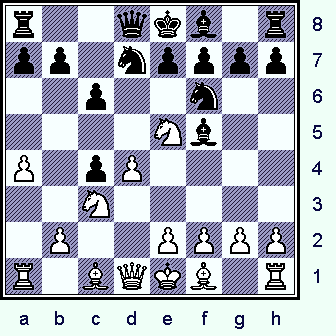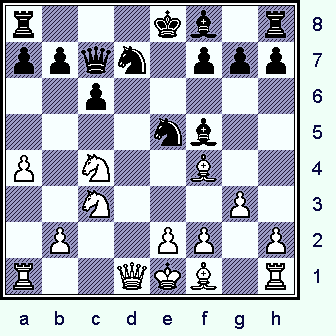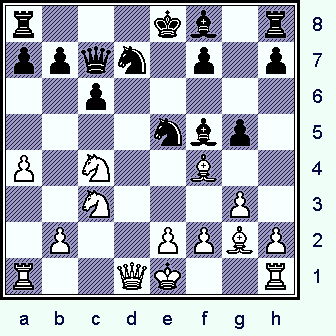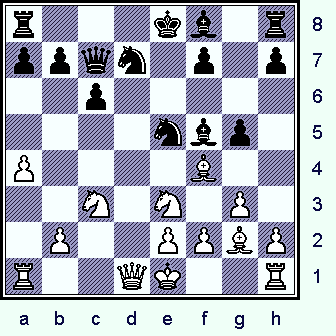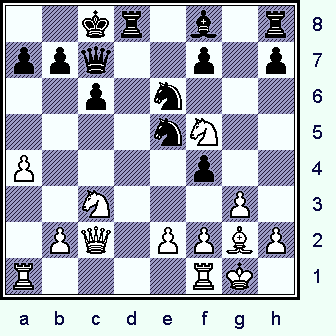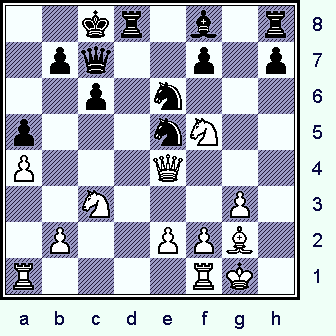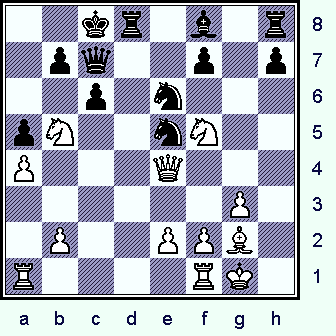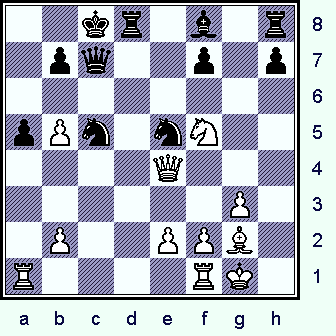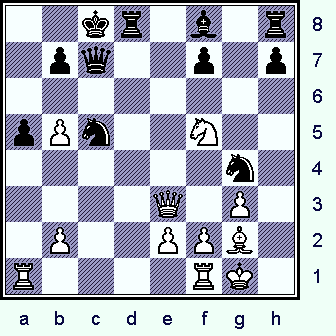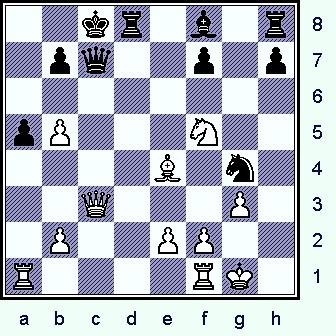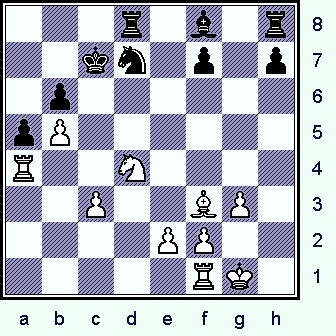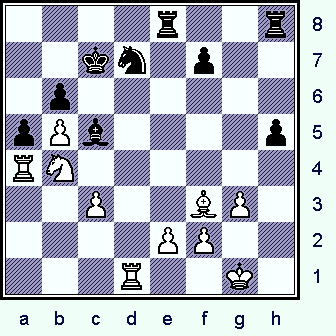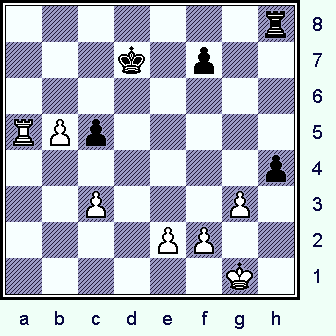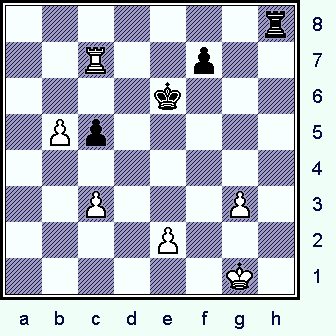GM Alexei Shirov
(2699) - GM Penteala
Harikrishna (2680)
[D17]
ICT,
Aerosvit GM
Foros, UKR; (Round
# 09) / 26,06,2006.
[A.J. Goldsby I]
One of my favorite players of the last
fifty years would easily have to be GM Alexei Shirov.
Why do I say this? Its a complicated
issue to summarize, but here are a few of the more salient points:
# 1.)
Shirov rarely makes quick or dull GM draws, something that I (personally) deeply detest.
{Unless he is having a bad result, he generally is the epitome of a real
chess fighter.}
# 2.)
Shirov games are nearly always a joy to go over, they are full of witty tactics and ingenious positional ideas.
# 3.)
As an author, his series of books,
("Fire on Board"); are a real treasure
to possess; and they have made for some of the most absorbing study that
I have ever had the pleasure to undertake.
# 4.)
Obviously Shirov is an extremely strong player. He trounced Kramnik in a match, and it should have been
Shirov - NOT Kramnik! - who had the right to play Garry Kasparov in 2000.
*** *** *** *** *** *** *** *** *** *** *** *** *** *** *** *** *** *** *** *** *** *** *** *** ***
Another positive aspect to this particular encounter is that it makes the perfect
compliment (in terms of openings) to
a game that I recently
annotated.
1.d4 d5;
2.c4 c6;
This is the "Queen's Gambit Declined." (The accepted version is to play 2...PxP/c4 in this line.)
Black can also decline the gambit
with 2...e6; for a fairly thorough look at the standard QGD, see my analysis
of one of the games of the World Championship Match between the legendary players, Jose R. Capablanca
and Alexander A. Alekhine.
3.Nf3 Nf6;
4.Nc3 dxc4;
This leads to a "Slav, proper" ... ... ...
the main idea of this opening is to develop the QB outside the pawn chain, and avoid the bad endgames inherent in many of the other (Black) variations and systems of the Q.G.D.
(See my WCA
May lesson for a fairly detailed look at the theory of this particular opening system.)
[ After the moves:
4...e6; 5.e3 Nbd7;
we are still in the same country,
but now we are in the territory
of the "Semi-Slav" systems of this opening.
(A fairly common transposition.)
{See my column
for January for a brief
survey
of the Semi-Slav lines.} ]
White can now play a whole range of lines, 5.e4 would be the sharpest ... and is a true gambit.
(White does not strive to immediately regain the pawn.) In this game, White plays the main line, (a2-a4); which prevents the second player from attempting to keep his pawn on c4. (5.a4
prevents ...b7-b5. - ye olde editor)
5.a4 Bf5;
6.Ne5!?, (Maybe - '!')
This is a perfectly playable move, but the most common move here is 5.e3 at this point.
[ For the
continuation of:
6.e3 e6; 7.Bxc4 Bb4;
8.0-0 Nbd7; 9.Qe2 0-0; 10.e4 Bg6;
11.Bd3,
"+/="
see any good reference work.
[Like MCO-14, page # 477; column # 58, & all relevant notes.] ]
6...Nbd7;
('!') (development)
{See
the diagram given - just below.}
I like this move, it forces White into a decision ... and avoids some sharper continuations ...
where the second party has had poor results as of late.
r2qkb1r/pp1npppp/2p2n2/4Nb2/P1pP4/2N5/1P2PPPP/R1BQKB1R w
After 6...e6; play can transpose, or White can opt for some much wilder lines, (see the note just below).
[ Black can also play:
6...e6; 7.f3!?,
This represents one of the sternest tests of Black's opening - if Black reacts too
passively, he can quickly get an inferior game.
( Another way to play this position would be:
7.e3 Nbd7; 8.Nxc4 Bb4;
9.Be2 0-0; 10.0-0, "+/=" 10...a5;
when White has a slight edge, but Black has a solid and playable position.
(There were only two games in the on-line database, and neither one was
a "GM versus GM" encounter. Since the play in both games was irregular,
I do not bother to quote them here.) )
7...Bb4; ('!')
This is also an ultra-sharp reply, which theory (at one time) considered to be unsound.
{It is also a prelude to some incredibly fierce tactics.}
8.e4 Bxe4; 9.fxe4 Nxe4!!;
(A perfectly sound sacrifice, the second player gets a ton of play and three healthy Pawns
for a minor piece.)
10.Bd2 Qxd4; 11.Nxe4 Qxe4+;
12.Qe2 Bxd2+; 13.Kxd2 Qd5+!; 14.Kc2 Na6!;
15.Nxc4 0-0-0!; 16.Qe5 f6;
17.Qe3!? Kb8; 18.Be2 e5!?;
"~"
when Black had a solid position, this game eventually ended in a
draw.
GM V. Kramnik - GM V. Ivanchuk; /
ICT, 12th Super-GM (Inv.)
Linares, ESP; 1994. (31 moves.)
[ See MCO-14, page # 477, column # 55, and all notes. ] ]
Now - for the following series of moves - we follow a "book" line.
7.Nxc4 Qc7;
8.g3 e5;
9.dxe5 Nxe5; 10.Bf4 Nfd7; {See
the diagram just below.}
Apparently, this is a popular line for both sides, I found dozens of recent examples in the database.
(It is also a very old position, the earliest example in the db was:
J. Capablanca - M. Vidmar; Karlsbad, GER; 1929.)
r3kb1r/ppqn1ppp/2p5/4nb2/P1N2B2/2N3P1/1P2PP1P/R2QKB1R w
Note how both sides have plenty of pieces and pawns hitting the center of the board, and both players can quickly castle from this position as well. 11.Bg2
g5!?; (Inferior/dubious?)
{See the diagram just
below.}
Black plays an extremely aggressive move, whether or not it is sound (or best), I am not really sure.
r3kb1r/ppqn1p1p/2p5/4nbp1/P1N2B2/2N3P1/1P2PPBP/R2QK2R w
My own take on this move is that it is both premature and anti-positional, and therefore wrong.
(It is also a gross violation of the 4 main opening principles that I teach my students.)
So now you have to ask yourself: "Why a GM would play such a reckless move?"
I think
that the answer has two main points:
# 1.)
Black does not believe that it loses by force;
# 2.)
GM P. Harikrishna is a strong and aggressive player ... who likes to
win.
Any master worth his rating would tell you that, in order to
defeat a strong opponent, you have
to upset the normal balance of the chess game ... at some point.
{Especially when you are playing the Black pieces.}
Therefore I would say that the short answer is that Harikrishna played this move because he wanted to
win. (Another thing I should add about ...g5 here is it has been played many times before, Anand has won a few fine games with this move. And according to a CD-ROM on this opening, 11...g5 has been played over 150 times!)
Of course, one of the main points of 11.g5!? is that it is very forcing, and it breaks the pin on the h2-b8 diagonal and also denies White quite a few options. (I.e., not 12.BxP/g5??, as this will drop a whole Knight on c4.) And according to the latest version of the "Fritz Power-Book," this is the second choice of masters, and has performed reasonably well for Black.
(PR=2503)
[ Perhaps a better line would have been the following:
(>/=)
11...f6; 12.0-0 Nc5;
13.e4 Bg6; 14.Qe2!? Be7; 15.Rad1 0-0;
"~"
when White might be a fuzz better here, but Black's side of the board is very playable.
(There are only a few games in the db, and Black has not lost a single encounter.)
See the master-level contest:
GM Juan M. Bellon-Lopez (2480) - GM Jesus Nogueiras (2520);
ICT, Garcia Memorial
(Premier) /
Santa Clara, Cuba; 1998.
{Black won a long game, search
for this contest on another website.} ]
12.Ne3!?,
(Best, worst, or ...) {See the diagram just
below.}
Shirov - true to form - finds a move, while perhaps not the best, quickly makes this game a bottomless pit of tactics.
Was this move part of Shirov's pre-game preparation? Possibly. It is also possible, however, that Shirov played Ne3 in an attempt to steer his wily opponent away from his prepared analysis lines.
r3kb1r/ppqn1p1p/2p5/4nbp1/P4B2/2N1N1P1/1P2PPBP/R2QK2R b
Whatever Shirov's motivations for playing Ne3 on move twelve, the game now becomes a dogfight instead of a positional grind.
[ The simplest approach would have to be:
12.Bxe5 Nxe5; 13.Qd4 f6;
14.0-0 Be6; 15.Ne3!, "+/="
{Diag?}
when several different programs award a small edge for White.
And I must point out that while this might have been the 'easiest' way
to go, it is no guarantee it was the best for White. (In these sharp lines,
it might take years to finally determine the best method and variations ...
for both sides!) ]
12...gxf4;
13.Nxf5 0-0-0;
I have said this before ... and I will say it again - for the benefit of those who may be unaware of this concept.
---> When you castle on opposite sides, all refined strategies are quickly thrown out the window - it often becomes a race to mate the opponent's King. (Or a question of who has the bigger tactical club.)
Of course, the Knight on f5 severely limits Black's options in this position, 13...Bc5?!
is met by 14.Ng7+, and the second player's
King is embarrassed.
[ Black may have already been without good choices, for after the moves:
(</=) 13...fxg3; 14.hxg3 Bc5!?;
White has the option of Ng7+, when Black
would lose the right to castle. ]
14.Qc2 Nc5;
This is a normal-looking move for Black in this position, and the placing of the BN on the c5-square does not adversely affect the computer's overall evaluation of this position.
[ Black has also tried:
14...Ng4;
15.a5 fxg3;
16.hxg3 a6; 17.Ra4 Ndf6; 18.Ne4,
"+/="
White is only slightly better here, (Pawn Structure); but White went
on to win (1-0) a nice game in a total of forty-five total moves.
GM Garry Kasparov (2851) - GM Alexander Morozevich (2748);
ICT,
Master's "A" (section) /
Wijk aan Zee, NED; 2000.
(45) ]
15.0-0
Ne6; "~" (Unclear, possibly "=") {See the diagram just
below.}
This would be a good time to take a long, hard (and objective) look at the chess board, in order to try and appraise the current situation.
2kr1b1r/ppq2p1p/2p1n3/4nN2/P4p2/2N3P1/1PQ1PPBP/R4RK1 w
Both sides have castled, pieces are equal, and both sides have six pawns. I would have to say that the chances from the current set-up are roughly equal ... and Fritz seems to agree with this judgment.
16.Qe4!?,
(Maybe - '!?')
White plays one of the most aggressive moves in this position; (The first party could have also chosen 16.Rad1 or 16.Ne4 as
well.). 16...fxg3;
This looks like a sensible move, and the try of 16...Rg8 is to be examined here as well. (But that might leave Black's RP unprotected, and a potential long-term target.) {Naturally - White retakes the Pawn on g3, and also captures toward the center as well.}
17.hxg3 a5!?,
{See the diagram just
below.}
This looks like a natural move, (halting any further advances of the QRP by White); but it also weakens the Pawn structure
around the Black Monarch, however imperceptibly this weakening might at first appear. (Fritz likes 17...Rg8; while I prefer
the sharp thrust of 17...h7-h5.)
2kr1b1r/1pq2p1p/2p1n3/p3nN2/P3Q3/2N3P1/1P2PPB1/R4RK1 w
The odd thing is that we are still within the confines of "book" ... Black's seventeenth move has been played before. 18.Nb5!?,
('??' or probably '!!') {See the diagram
given - just
below.}
What to make of such a move?
2kr1b1r/1pq2p1p/2p1n3/pN2nN2/P3Q3/6P1/1P2PPB1/R4RK1 b
All I can say is this is not a move that I would seriously consider, even if I had all day to look at the board and a computer to help me. (And this is why I love looking at Shirov's games!)
A "Tal-like"
sacrifice, one obvious idea, is that with a Bishop pointing right into the hear of Black's position and
possible open lines for both of the Rooks, White could quickly gain the upper hand. (And after days of analysis, I would have to say that the correct verdict of White's 12th move would have to be Nb5!!!)
After two weeks of studying this game, I was amazed to learn, (today, July 11th); that this is
NOT a new move! Further, Shirov has even been on the Black side of this position before ... and actually drew that game!!! (Before this game, 18.Nb5 had been played in three other master-level contests.)
[ After the moves:
18.Rfd1 Bc5; "="
the position appears to be equal. ]
Black decides to accept the challenge.
(It may not matter, as the computer shows that after 18...Nc5; 19.Qe3!, Black's only move is to take on b5.)
18...cxb5;
19.axb5 Nc5; (Box?) {See the diagram just
below.}
This could be forced for Black.
2kr1b1r/1pq2p1p/8/pPn1nN2/4Q3/6P1/1P2PPB1/R4RK1 w As
we examine a few variations, we quickly discover that some of the alternatives could be (much) worse.
[ After the {seemingly} natural moves:
(</=) 19...b6!?; 20.Rfc1 Nc5;
21.Qb1! Kb8?!; 22.b4,
'±' {D?}
White has a strong attack against his opponent's King.
(Note that
22...PxP/b4??? is instantly punished by the swift reply,
23.Ra8# mate.)
***************************************************************************************************
Once again, Black had another possibility here. With the moves of the following line:
(</=)
19...Nd7; 20.Rxa5 Kb8;
21.Rfa1 Nb6; 22.Ra7 Rd7;
23.Nd4! Qc8; ('[]' ?)
This is forced.
( It would be a mistake to take on d4 here.
For example: </= 23...Nxd4?; 24.Qe8+ Qd8;
25.Rxb7+ Kc8; 26.Rc1+ Nc6;
27.bxc6!! Rd1+!; 28.Rxd1 Qxe8;
29.Bh3+!, ("+/-") & Black gets mangled. )
24.Qe5+! Bd6; 25.Rxb7+! Rxb7;
26.Qxd6+ Qc7; 27.Nc6+ Kc8;
28.Qa3!, ("+/-")
... (and now) three different programs verify that Black is unable to defend his King
from this position. ]
20.Qe3!,
Shirov keeps it complicated.
[ The move of:
20.b6!?,
was an interesting possibility. ] 20...Ng4?!; {See the diagram just
below.}
Black cracks under the pressure.
2kr1b1r/1pq2p1p/8/pPn2N2/6n1/4Q1P1/1P2PPB1/R4RK1 w
My analysis might show that Black might be lost ... no matter what. Be that as it may, 20...Ncd7 still might have been Black's best defense.
[
Probably a little better was:
>/= 20...Ncd7!;
21.Rfc1!,
The natural move ...
although the playing the Queen to a7 also begged to be investigated.
21...Bc5[];
This is completely forced for Black here.
(Instead, after the continuation: </= 21...Nc5?; ('??')
22.b4 axb4?!;
23.b6! Qxb6;
24.Qxe5 Rg8;
25.Ra8+ Kd7; 26.Rd1+ , "+/-" and Black is quickly mated.)
22.Rxc5!! Nxc5;
23.b6! Qxb6; 24.Qxe5,
"+/=" ("--->")
{Diagram?} and White's
attack continues nearly unabated ... and at only a minimal material
disadvantage. ]
21.Qc3! Ne4!?;
('?!') (TN?)
{See the analysis section ... just below.}
This could be a further error, but I doubt if it even matters anymore.
However, 21...Qe5 was probably Black's best defense here.
(I made this comment with the computer off, even before I
discovered that playing the BQ to e5 is also the 'book' line.)
(As far as I could tell, Black's last move was brand new to master praxis ... at least according to repeated searches of the on-line database.)
[ Instead, after the continuation:
</=
21...Rg8?!; 22.Rxa5 Kd7!?;
(The box shows this to be forced. It also makes sense, Black tries to run away from White's attack.)
23.b4
Ne6; ('?')
This looks like the most natural move here, but Fritz shows it to be a mistake.
(Even after the supposedly superior line: 23...Ke6; 24.Nd4+ Rxd4;
Not much choice here, if ...Kd7; then b6! followed by b4xN/c5 will win on the spot.
25.Qxd4 Nd7; 26.Bh3 f5; Otherwise f3 will win a piece.
27.b6!! Nxb6; 28.Rb5!, "+/-" and White wins ... because if the Black saves his
Knight on b6, then Qd5+ wins the Black Rook on g8.)
24.Bc6+!!
bxc6; 25.Ra7!, "+/-"
... (and) White wins Black's Queen, because if QxR/a7, then the move of QxP/c6# (mate)
ends the suffering.
*********************************************************************************************************
*********************************************************************************************************
After the moves: (>/=) 21...Qe5;
22.Qf3! Qe4; ('[]')
Fritz considers this to be forced.
( Even worse would be: </= 22...Nf6?; 23.Rxa5 Nfe4!?;
24.b4, ("+/-") and White wins a piece. )
23.Qxe4
Nxe4; 24.Bxe4 b6;
This appears to be the logical choice for Black ... although other moves might be playable.
*** *** *** *** ***
*** *** *** *** *** *** *** *** *** ***
*** *** *** *** *** *** *** *** *** ***
*** *** *** *** ***
( Instead, Black played: 24...Bb4!?;
and managed ... somehow ... to actually hold his position.
{However, the computer shows that both sides may have missed the best line of play.}
GM Leif E. Johannessen (2519) - GM Alexei Shirov (2726); Bundesliga / Germany, 2004. (34)
(This game was drawn, ½-½, in 34 strange and confusing moves.) )
*** *** *** *** ***
*** *** *** *** ***
*** *** *** *** ***
*** *** *** *** ***
*** *** *** *** ***
*** *** *** *** ***
25.Rfc1+
Kb8; 26.Rd1 Bc5; 27.e3 Rxd1+; 28.Rxd1
Kc7; 29.Kg2, '±' (Maybe "+/-")
{D?}
Black basically has a lost ending. (Black is a Pawn down with a rotten Pawn structure - the
second player has three pawn islands.)
*********************************************************************************************************
*********************************************************************************************************
The computer seems to think that Black's best defense would probably be:
>/= 21...Qd7; ('!')
22.Rxa5 Qxf5; 23.Ra8+ Kd7;
24.Rxd8+ Kxd8; 25.Qxh8 Nd7; 26.b6!, "+/="
but Fritz, (and several other programs as well); shows that White is still clearly better. ("+/")
[The material situation here is not that bad, two Knight's for Black versus White's
Rook and
two Pawns. However, the exposed position of Black's King leads me to believe that Black
cannot defend this.] ]
The next series of moves , (until Black's 26th move); looks to be close to best for both sides.
22.Bxe4,
'±' {See the diagram just below.}
This is probably best, ('!') taking the Rook on h8 with 22.Qxh8 allows Black some counterplay after the retort, 22...Bc5.
2kr1b1r/1pq2p1p/8/pP3N2/4B1n1/2Q3P1/1P2PP2/R4RK1 b
White already stands clearly better, some programs consider White's advantage to be decisive here.
Now - due to White's threats - Black is forced to take on c3 ... and undouble Shirov's QNP's.
22...Qxc3;
23.bxc3 b6;
24.Nd4 Nf6; 25.Bf3 Kc7;
26.Ra4 Nd7; {See the diagram just below.}
I guess that this is OK, however 26...Bc5; (the more natural-looking move), might have been a fuzz better. (But I don't believe that it would have changed the final outcome of this struggle.)
3r1b1r/2kn1p1p/1p6/pP6/R2N4/2P2BP1/4PP2/5RK1 w
This is the current situation ... that we have on the chess board.
27.Nc6 Re8;
28.Rd1 Bc5; 29.Nb4 h5!?; {See the diagram given - just
below.}
Playing the Black Rook to e5 might have been the most solid try for Harikrishna here.
4r2r/2kn1p2/1p6/pPb4p/RN6/2P2BP1/4PP2/3R2K1 w
In any case, Black could not take the WN on b4, as the result was that his position would have been severely degraded.
(See the note below.)
[ Not advisable would have been:
</= 29...axb4?; 30.Ra7+ Kc8;
31.Rdxd7 Re7; (Forced.)
Otherwise White plays Rdb7 to be followed by Ra8 mate.
32.Rxe7 Bxe7; 33.Ra8+ Kc7;
34.Rxh8 bxc3; 35.Be4, "+/-"
and it is time for Black to resign.
] The
next few moves look to be forced/best (for both parties).
30.Na6+ Kc8;
31.Bc6 Re7;
32.Bxd7+ Rxd7; 33.Rxd7 Kxd7;
34.Nxc5+ bxc5; 35.Rxa5 h4; {Diagram.}
Black has shown great skill ... honestly. (A lesser player would have definitely fallen for one of Shirov's many tricks ...
or even would have been mated.)
7r/3k1p2/8/RPp5/7p/2P3P1/4PP2/6K1 w
However, you don't have to be an expert chess player to realize that this R+P endgame, Black being down two full pawns, is completely untenable for Black.
GM Harikrishna plays on for a few moves, perhaps out of inertia, (or the trained desire to reach the time control); before giving up. 36.Ra7+ Ke6;
37.Rc7 hxg3; 38.fxg3, "+/-" Black Resigns. {See the diagram just
below.}
Black gives up the ghost, soon he could be as much as three pawns down.
7r/2R2p2/4k3/1Pp5/8/2P3P1/4P3/6K1 b
A wonderful game by Shirov, typical of this player when he plays his very best chess.
< I also have a confession to share with you, I originally wanted to just quickly annotate this game, and it was only after I began to explore its depths ... that it became - by default - my main game for this month's column. (My normal method is to pick one game from the TWIC db and go from there.) >
Copyright (c) A.J. Goldsby, 2006. All rights reserved.
1 - 0
The analysis for
this page was prepared with the excellent programs,
ChessBase
8.0 and ChessBase
9.0.
The HTML was
polished with several different tools and programs, (mostly
FP) ... the text was checked for spelling with
MS Word.
The diagrams were
created with the program, Chess
Captor 2.25.
|


